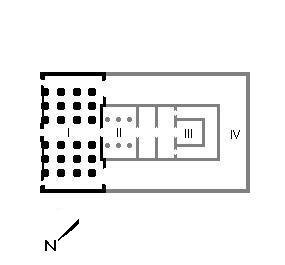
Temple of Khnum Esna: Visiting Hours, Tickets, and Historical Sites
Date: 19/07/2024
Introduction
The Temple of Khnum, located in Esna, Egypt, stands as a monumental testament to the grandeur of ancient Egyptian architecture and religious devotion. Dedicated to Khnum, the ram-headed god of creation and the source of the Nile River, this site encapsulates a rich tapestry of history, culture, and spiritual significance dating back to the Ptolemaic period (332–30 BCE). The temple, with its origins as a place of worship since the New Kingdom (1550–1070 BCE), showcases the architectural and artistic advancements of the Greco-Roman period, making it a must-visit destination for history enthusiasts and casual travelers alike (Ancient History Encyclopedia).
Table of Contents
- Introduction
- History of the Temple of Khnum
- Religious Significance
- Architectural Features
- Rediscovery and Preservation
- Modern-Day Significance
- Visitor Experience
- FAQ
- Conclusion
History of the Temple of Khnum
Origins and Early Construction
The Temple of Khnum, dedicated to the ram-headed god of creation and the source of the Nile River, has origins dating back to the Ptolemaic period (332–30 BCE). The site itself was a place of worship since the New Kingdom (1550–1070 BCE), with the current structure reflecting the architectural styles of the Greco-Roman period.
Ptolemaic Period Developments
During the Ptolemaic period, significant expansions and renovations took place. The Ptolemies, of Macedonian Greek origin, embraced Egyptian religious traditions. The hypostyle hall, constructed during this time, is supported by 24 columns adorned with intricate floral capitals and hieroglyphic inscriptions depicting deities and rituals (Ancient History Encyclopedia).
Roman Period Enhancements
The Roman emperors continued enhancing the temple, especially under emperors like Claudius (41–54 CE) and Vespasian (69–79 CE). The temple’s façade, completed during this era, features detailed reliefs depicting emperors offering gifts to the gods in traditional pharaonic poses (Britannica).
Religious Significance
The Temple of Khnum was a center for religious festivals and ceremonies, with Khnum believed to create humans from Nile clay. The temple’s association with creation and fertility made it vital for birth and renewal rituals. It also played a crucial role during the annual Nile flood, essential for agriculture. Priests performed ceremonies to honor Khnum and ensure proper Nile inundation (World History Encyclopedia).
Architectural Features
The Temple of Khnum is renowned for its architectural prowess. The hypostyle hall, with towering columns, is decorated with depictions of gods, goddesses, and pharaohs, providing a rich tapestry of religious iconography. The hall’s ceiling features astronomical scenes and representations of the sky goddess Nut, conveying important religious concepts (Egypt Tours Portal).
Inscriptions and Reliefs
The temple’s walls are covered with inscriptions and reliefs offering insights into ancient Egyptian religious practices. Hymns to Khnum, descriptions of rituals, and records of offerings are found here. One notable relief depicts the goddess Neith presenting the pharaoh with kingship symbols, underscoring the temple’s role in legitimizing authority (ARCE).
Rediscovery and Preservation
The Temple of Khnum was rediscovered in the 19th century by European explorers. French Egyptologist Auguste Mariette conducted early excavations in the mid-1800s. Various archaeological missions have since worked to uncover and preserve the temple, which continues to attract scholars and tourists (SCA).
Modern-Day Significance
Today, the Temple of Khnum is recognized for its historical, architectural, and cultural significance. Preservation efforts are ongoing to protect the site from damage. Egyptologists continue studying the temple’s inscriptions and reliefs, providing new insights into ancient Egyptian society (Egypt Today).
Visitor Experience
Visiting Hours and Tickets
The Temple of Khnum is open daily from 9 AM to 5 PM. Tickets can be purchased on-site, with prices typically around EGP 60 for adults and EGP 30 for students. It’s advisable to check for updated pricing and hours before visiting.
Travel Tips
The temple is easily accessible from Luxor, making it a convenient addition to any itinerary. The best time to visit is during the cooler months from October to April. Guided tours are available, offering detailed explanations of the temple’s history and significance.
Nearby Attractions
While in Esna, visitors can also explore other historical sites such as the Temple of Esna and the Esna Lock. These attractions provide additional insight into the region’s rich history and culture.
FAQ
What are the visiting hours for the Temple of Khnum?
The temple is open daily from 9 AM to 5 PM.
How much are tickets to the Temple of Khnum?
Tickets typically cost EGP 60 for adults and EGP 30 for students.
How do I get to the Temple of Khnum?
The temple is accessible from Luxor, with various transport options available.
Conclusion
The Temple of Khnum in Esna, Egypt, is more than just a relic of a bygone era; it is a living testament to the enduring legacy of ancient Egyptian civilization. From its origins in the New Kingdom through its expansion during the Ptolemaic and Roman periods, the temple stands as a beacon of religious, cultural, and architectural significance. The intricate carvings, hieroglyphic inscriptions, and astronomical depictions within the temple offer invaluable insights into the religious practices and daily life of ancient Egyptians (Ancient History Encyclopedia).
Today’s visitors can explore this historical marvel, gaining a deeper understanding of its role in ancient Egyptian society while enjoying modern amenities and guided tours. Preservation efforts by the Egyptian Ministry of Antiquities and international organizations ensure that this site remains accessible for future generations to explore and appreciate (Egypt Today). As you plan your visit, consider the wealth of knowledge and cultural heritage that the Temple of Khnum offers, making it a unique and enriching destination for all who seek to connect with the ancient world (ARCE).
References
- Ancient History Encyclopedia, n.d., Khnum https://www.ancient.eu/Khnum/
- Britannica, n.d., Esna https://www.britannica.com/place/Esna
- World History Encyclopedia, n.d., Khnum https://www.worldhistory.org/Khnum/
- Egypt Tours Portal, n.d., Temple of Khnum https://www.egypttoursportal.com/temple-of-khnum/
- Egypt Today, 2021, Esna Temple of Khnum to be restored https://www.egypttoday.com/Article/4/104857/Esna-Temple-of-Khnum-to-be-restored
- ARCE, n.d., Temple of Khnum https://www.arce.org/resource/temple-khnum-esna
